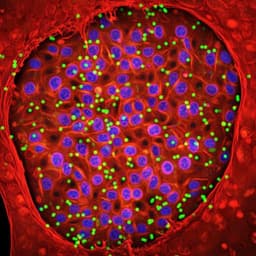
Physics
In situ electron paramagnetic resonance spectroscopy using single nanodiamond sensors
Z. Qin, Z. Wang, et al.
Discover the groundbreaking research by Zhuoyang Qin and colleagues on zero-field EPR spectroscopy utilizing nanodiamonds to unravel molecular dynamics in living cells. This innovative approach presents robust spectra that promise to transform *in vivo* EPR analysis.
~3 min • Beginner • English
Introduction
Electron paramagnetic resonance (EPR) is widely used to study molecules with unpaired electrons, including dynamic processes such as redox reactions and molecular motions. Achieving in situ or even single-cell EPR requires sensors that combine high spin sensitivity with biocompatibility. Conventional cavity-based EPR lacks sensitivity, while microscale sensors (e.g., MRFM, STM-based EPR, superconducting resonators) require cryogenics and vacuum. Nitrogen-vacancy (NV) centers in diamond offer single-spin sensitivity at ambient conditions and can be hosted in nanodiamonds, enabling in situ sensing in complex environments. However, using flexible, rotationally diffusing nanodiamonds as EPR sensors is challenging because NV centers have anisotropic magnetic responses; random tumbling alters transition frequencies/strengths and degrades control sequences used in DEER and cross-relaxation EPR. The research question is how to perform zero-field EPR with nanodiamond NV sensors in a way that is robust to random orientations of both target spins and the ND sensor itself. The study proposes and tests an amplitude-modulated zero-field EPR scheme whose resonance condition is independent of sensor orientation, enabling EPR in tumbling NDs and paving the way for in situ and in vivo EPR.
Literature Review
The paper situates the work within efforts to increase EPR sensitivity and applicability. Prior micro/nanoscale EPR sensors include magnetic resonance force microscopy, STM-based EPR, and superconducting microresonators, which improve sensitivity but require cryogenics and vacuum. NV-center-based sensing has demonstrated single-spin sensitivity and nanoscale EPR under ambient conditions, including detection of external spins and nanoscale zero-field EPR. Orientation sensitivity of NV controls has been a major obstacle in tumbling environments, with active approaches like optical tweezers or 3D tracking and optimal control proposed. Zero-field EPR removes target orientation dependence but not sensor orientation dependence; this work extends robustness to the sensor via amplitude modulation.
Methodology
Theory: The NV-target system at zero magnetic field is modeled with an NV zero-field splitting D = 2.87 GHz and a target spin splitting ω, coupled via dipole-dipole interaction d_ij S_i T_j. Direct resonant driving with a continuous microwave (MW) field B1 cos(D t) produces an NV Rabi frequency Ω = γ_NV B1 sinθ (γ_NV = 28.03 GHz/T; θ is angle between B1 and NV axis) and resonance when Ω/2 = ω, which depends on θ and leads to broadened, asymmetric spectra for tumbling NDs.
Amplitude-modulated scheme: Apply an amplitude-modulated MW field B1 cos(f t) cos(D t). Periodic amplitude modulation creates Floquet sidebands with splitting f; in the regime Ω ≪ f the first-order term dominates, yielding an additional NV longitudinal relaxation with a Lorentzian response centered at f = ω, independent of θ. The signal contrast after time t follows S ≈ 2^(-Γ1 t) (1 − 2^(-Γ2 t)), with Γ2 determined by NV and target decoherence. The effective coupling is reduced by a factor proportional to κ = Ω/f, but the resonance condition depends only on f.
Fixed-ND experiments: NDs (∼40 nm, carboxylated, 12–14 NVs per ND) are spin-coated on coverslips and measured in a home-built confocal microscope (532 nm excitation, APD detection). MWs are generated by an AWG (Keysight M8190a), amplified (Mini-Circuits ZHL-16W-43+), and delivered via a coplanar waveguide. Rabi oscillations are measured to identify dominant Ω per ND. Zero-field EPR spectra of intrinsic P1 centers in diamond are obtained by sweeping f while co-sweeping B1 to keep κ = Ω/f constant.
Tumbling-ND experiments: To allow rotation but restrict translation, NDs are tethered to amino-silanated coverslips using a long biotinylated PEG (20 kDa) “string” with streptavidin linkage; short mPEG (5 kDa) modulates ND density for single-particle observation. A 9:1 glycerol:water solution containing 25 mM vanadyl sulfate (VO2+) is prepared under N2 and added atop the ND-tethered coverslip to slow ion rotational diffusion and maintain acidity; the assembly is sealed under N2. Rabi measurements show rapid decay and slow variations consistent with ND tumbling. Zero-field EPR spectra are acquired by sweeping f in the mid-frequency range (avoiding strong background at D/2 ≈ 1435 MHz) with amplitude-modulated or equivalent off-resonant dual-tone driving; κ is controlled where applicable.
Target spin model: VO2+ in water at low pH exists as [VO(H2O)5]2+ with S = 1/2 and I = 7/2. At zero field, the hyperfine Hamiltonian has axial symmetry with A⊥ and A∥ (A_z), leading to 9 energy levels and allowed transitions with Δm_T = 0, ±1. Simulated spectra predict up to 12 observable peaks; some overlap with P1 signals.
Data acquisition: Spectra are obtained by repeating the pulse sequence up to 16 million times per point with a duty cycle of 1:19 to limit average MW power. Fits use Lorentzian peaks at theoretically constrained positions to extract hyperfine parameters and linewidths. Linewidth analysis includes contributions from NV dephasing, target intrinsic relaxation, dipole-dipole interactions between ions, and rotational diffusion (estimated using viscosity-dependent rotational correlation times).
Key Findings
- Orientation-independent resonance: With amplitude-modulated driving, the EPR resonance condition becomes f = ω, removing dependence on the angle θ between MW field and the NV axis. Simulations and experiments show elimination of tumbling-induced line broadening in peak positions.
- Fixed NDs, P1 centers: Zero-field EPR spectra display peaks at ≈130 MHz and ≈149 MHz corresponding to 14N P1 centers, consistent with theory and prior bulk measurements. Fitted mean peak positions: 129.9 MHz (peak 2) and 148.9 MHz (peak 3). Peak positions are independent of κ (Ω/f), while signal contrast increases with κ, matching theoretical predictions. A representative ND shows a dominant Rabi frequency Ω ≈ 65 MHz at 0.6 W input MW power.
- Tumbling NDs, vanadyl ions: Despite ND and ion rotational diffusion, clear zero-field EPR peaks are observed at approximately 780 MHz, 950 MHz, and 1150 MHz. Lorentzian fits (three-peak model) yield linewidths of 25 MHz, 58 MHz, and 42 MHz, respectively. From peak positions constrained by the vanadyl level scheme, fitted hyperfine constants are A∥ = 195 ± 2 MHz and A⊥ = 579 ± 8 MHz, differing from conventional EPR values (literature A⊥ ≈ 208.5 MHz, A∥ (A_z) ≈ 547 MHz). The discrepancy is attributed to an adsorption layer of VO2+ on ND surfaces altering the ligand environment.
- Spectral background and artifacts: A strong background appears near D/2 ≈ 1435 MHz due to off-resonant dual-tone components (D ± f). Overlap with P1 signals limits resolution of some vanadyl transitions.
- Linewidth budget: Estimated FWHM contributions at 25 mM VO2+ in 9:1 glycerol:water at 293 K: NV dephasing Γ2,NV ≈ 12 MHz; target intrinsic relaxation Rin ≈ 12 MHz; dipole-dipole interaction between ions Rdip ≈ 7 MHz (Rdip ≈ c × 272 MHz M−1); rotational diffusion Rrot ≈ 2 MHz (η ≈ 0.3 Pa·s), giving total estimated FWHM ≤ 66 MHz, in reasonable agreement with measured values. In pure water, Rrot would rise to ~600 MHz, making measurements infeasible.
- Measurement throughput: The vanadyl spectrum required ~7 days of acquisition with ~16 million sequence repetitions and a 1:19 duty cycle to limit average MW power (<1 W).
- Robustness: The method is robust to sensor tumbling and to other ions in solution, since zero-field peak positions depend only on intrinsic target interactions.
Discussion
The study addresses the central challenge of ND-based EPR in tumbling environments by shifting the resonance condition from the orientation-dependent NV Rabi frequency Ω to the modulation frequency f, which is independent of ND orientation. This enables zero-field EPR using flexible, randomly rotating NDs. Experiments verify orientation robustness on P1 centers (fixed NDs) and demonstrate in situ detection of vanadyl ions in solution with tumbling NDs, confirming that clear spectra can be acquired without stabilizing ND orientation or implementing complex tracking/optimal control.
The extracted vanadyl hyperfine parameters suggest sensitivity to local ligand fields near the ND surface, highlighting the potential of nanoscale zero-field EPR to probe interfacial chemistry in complex media. Linewidth analysis indicates that major broadening mechanisms (NV dephasing, ion–ion interactions, and rotational diffusion) can be mitigated by improving ND quality, reducing concentration, and operating in solid-like environments, implying future gains in spectral resolution and sensitivity. The approach’s zero-field operation reduces susceptibility to magnetic inhomogeneity and maintains robustness to the presence of other ions, as transitions are defined by intrinsic hyperfine interactions.
Conclusion
The work introduces and validates an amplitude-modulated zero-field EPR approach that renders nanodiamond NV-based EPR spectroscopy robust to random sensor orientation. The method is experimentally confirmed by observing P1 center spectra with orientation-independent peak positions and by detecting vanadyl ion spectra in solution using tumbling NDs. Extracted hyperfine constants for vanadyl ions indicate sensitivity to local environments, suggesting applications in probing biochemical interactions at the nanoscale and in complex biological settings. Future work should focus on enhancing spectral resolution and efficiency by improving ND coherence (high-purity/surface-engineered NDs), reducing ion concentration, employing solid-state samples to limit rotational diffusion, leveraging noise-insensitive transitions, and adopting advanced readout (e.g., spin-to-charge conversion). Parallel measurements with ND ensembles could further improve throughput for in vivo or single-cell applications.
Limitations
- Spectral resolution limited by linewidth contributions from NV dephasing, ion intrinsic relaxation, dipole–dipole interactions, and rotational diffusion; measurements in pure water are impractical due to high Rrot.
- Long acquisition times and low signal contrast (e.g., ~7 days for vanadyl spectra; Rabi contrast ~10%) limit throughput; current duty-cycle constraints to manage MW heating reduce efficiency.
- Potential MW heating in biological samples, especially for high-frequency targets requiring higher MW power.
- ND size (~40 nm) may be suboptimal for some cellular applications; smaller NDs can reduce uptake barriers but may suffer from reduced charge-state stability and coherence if not surface engineered.
- Overlapping signals (e.g., P1 centers) and strong background near D/2 complicate resolution of certain transitions.
- Variability in extracted parameters across different NDs suggests surface and NV-depth dependence; single-ND heterogeneity adds uncertainty.
- Experimental constraints (e.g., lack of blank control due to NV contrast degradation) and reliance on glycerol mixtures to slow ion rotation may limit generalizability to native aqueous environments.
Related Publications
Explore these studies to deepen your understanding of the subject.







